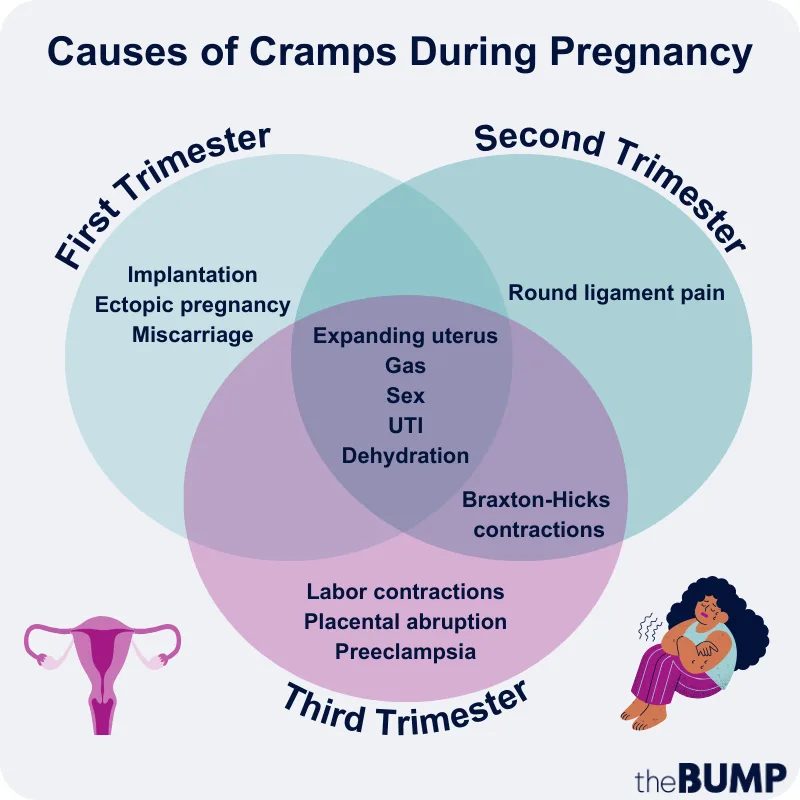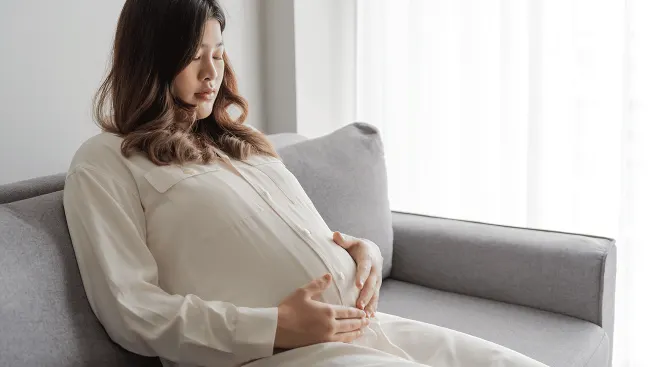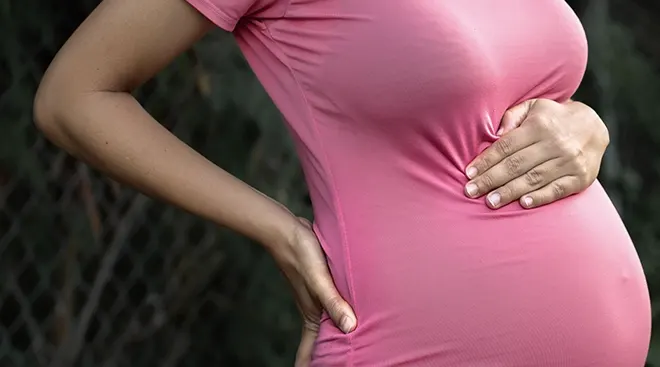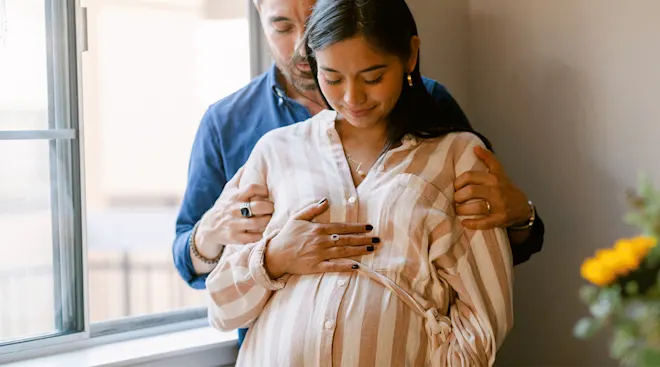What to Know About Cramps During Pregnancy
Feeling cramps during pregnancy can be confusing and concerning, but it’s par for the course and a normal part of the hormone-filled journey. In fact, you might notice some cramping before you even realize you’re expecting: For some, it’s one of the earliest signs of pregnancy. Moreover, those pregnancy cramps can come and go or continue throughout all three trimesters.
“I had cramps for about two weeks straight before I got my positive pregnancy test,” shares The Bump community member Charlie0424. “I took tests like crazy, but didn’t get a positive result until four days after my missed period. It doesn’t feel like regular cramping for me, but more like a pulling and aching.”
Curious why you might experience cramps during pregnancy? Keep reading to get the lowdown on what causes cramping during pregnancy, what you can do to ease the discomfort and if there are any red flags to look out for.
- Mild and occasional cramping during pregnancy is very normal. It’s caused by everything from your uterus getting bigger to gas to round ligament pain.
- Serious conditions such as ectopic pregnancy, preeclampsia and placental abruption can also cause cramping. Check in with your doctor if your pregnancy cramps are severe or persistent.
- To treat pregnancy cramps, you can use a warm compress, take a bath, stay hydrated and, if needed, take an over-the-counter pain reliever like Tylenol.
Are cramps normal during pregnancy? “As long as the cramping is not severe, it happens occasionally and it gets better with time and intervention, it’s usually not a cause for concern,” says Anne Olsen, an ob-gyn and clinical instructor with Mount Sinai in New York City. That said, it’s important to note that “what’s normal” will vary from person to person and pregnancy to pregnancy. It’s also important to distinguish between discomfort and acute pain, as everyone’s tolerance will vary, adds Cynthia Flynn, MD, a Florida-based ob-gyn with JustAnswer. This is why it’s so important to listen to your body and establish your personal baseline for what’s normal when it comes to pregnancy cramps.
Wondering how long cramps during pregnancy may last—or whether cramps may last all throughout pregnancy? Unfortunately, they can! But, as is true with many other aspects of pregnancy, this is subjective, says Olsen. “Some women may go through an entire pregnancy without experiencing any cramping until labor starts. [Others] experience pregnancy cramping as early as the first trimester, and it may persist until delivery. Both scenarios can happen in a completely normal and healthy pregnancy,” she says.
As for individual cramps, they should be fairly mild and sporadic, explains Rebekah Mustaleski, CPM-TN, a certified professional midwife and compression director with Motif Medical. “It shouldn’t make you stop what you’re doing, it shouldn’t be happening consistently and you shouldn’t experience bleeding with it,” she explains. If you have sharp, intense abdominal pain that makes you stop your activities or takes your breath away, you’ll want to reach out to your provider right away.
I kept feeling a pervasive mild achiness in my abdomen before I even knew I was pregnant. I kept waiting for my period to come—like, ‘It’s got to be coming any day now, right?!? Oh wait!’
There are actually a few different reasons why you might experience early pregnancy cramps in those first few weeks and months. Some people may not even notice cramping during early pregnancy, says Christine Greves, MD, an ob-gyn at the Orlando Health Women’s Institute: “It depends on the person and how sensitive they are.” However, if you do feel a dull, nagging ache, these could be some causes driving first trimester cramps:
Fertilized egg implantation
Before you have a missed period, an egg that’s been fertilized needs to implant in the lining of your uterus where it’ll grow—and that can come with a little discomfort. Implantation cramping is completely normal, and “may feel like a little twinge, aching or pulling sensation,” Greves says. It may also be accompanied by some light spotting called implantation bleeding. It’s worth noting that implantation happens a few days after you’d typically expect to menstruate; if you don’t have a predictable cycle, it can be extra confusing to determine if you’re experiencing period cramps vs. early pregnancy cramps (so you might want to take a pregnancy test).
Expanding uterus
Early pregnancy cramps are often caused by the rapid expansion of your uterus along with your growing baby, says Theresa Rose, DO, an ob-gyn with Northwestern Medicine. “Your uterus is undergoing a lot of change in the first trimester,” she explains. “It’s going from being just in the pelvis to becoming an abdominal organ and moving out of the pelvis.” Basically, some mild pregnancy cramping could be the result of your muscle fibers stretching and organs shifting.
Gas
During the first trimester, your gut motility (aka the speed that things move through your intestinal tract) slows down, due, in part, to sudden hormonal changes. That can lead to unpleasant gastrointestinal symptoms such as bloating, gassiness and constipation. If this is the case, you’re not experiencing early pregnancy cramps per se, but rather a byproduct of all the physical changes happening in your body. It’s “a different kind of cramp, but still normal,” says Jonathan Schaffir, MD, an ob-gyn at the Ohio State University Wexner Medical Center.
Sex
Sex can be another cause of cramping during pregnancy. This is due to the release of oxytocin after an orgasm, which can trigger your uterus to contract, Olsen says. “The contractions are usually transient and resolve with time.” (Note that it’s a myth that sex during pregnancy can hurt baby—as long as you don’t have any complications and have been cleared by your doctor, intercourse is safe.)
While cramping in early pregnancy is generally harmless, it can be a sign that something is wrong—especially when it’s severe, or accompanied by heavy bleeding or unusual discharge, Olsen says. Below, some more serious causes for cramps during early pregnancy that you’ll want to flag with your ob-gyn immediately:
Urinary tract infection
You’re more at risk of getting a UTI around or after the sixth week of pregnancy, according to the American Pregnancy Association (APA). If your pregnancy cramps are accompanied by frequent urination, a burning sensation when you go to the bathroom or a fever, odds are you have a UTI. But, while they may be common, you’ll still want to mention it to your provider sooner rather than later—if left untreated, a UTI could become a kidney infection, notes Alison Cowan, MD, an ob-gyn at Boulder Medical Center in Louisville, Colorado. Kidney infections are also treatable in pregnancy, but can lead to sepsis and cause preterm labor if not treated soon enough.
Ectopic pregnancy
According to Olsen, if you’re feeling cramping and pain on one side of your abdomen, it could be a sign of an ectopic pregnancy. This is a rare complication that occurs when a fertilized egg grows outside of the uterus. Along with one-sided cramps, you may also experience vaginal bleeding, low back pain, sudden and sharp abdominal pain and dizziness, according to the American College of Obstetricians and Gynecologists (ACOG).
Miscarriage
“Severe cramping that’s associated with bleeding can indicate an ongoing miscarriage,” Olsen says, particularly if it occurs before the 20th week of pregnancy. If you experience any abnormal bleeding or feel like something’s wrong, reach out to your provider immediately or go to the emergency room.
While these are scary things to think about, rest assured that a little pelvic ache by itself isn’t really cause for concern. “As long as the cramping is mild and not associated with bleeding, it’s usually nothing to be concerned about,” Olsen says.
I was getting some pains this morning which I passed off as maybe stretching pain, but now I’m convinced they’re gas cramps because I seem to have the runs today… I know, TMI, sorry!
Many of the suspects for first trimester cramps during pregnancy, such as gas, constipation, urinary tract infections and an expanding uterus will also pop up in the second trimester. Below, a few other reasons you may experience cramps during pregnancy at this stage:
-
Round ligament pain: This is a common source of pain and cramping during pregnancy in the second trimester. The round ligaments are “rope-like connective tissues” on either side of the uterus, which help to support it, Olsen explains. But as the uterus expands during pregnancy, it pulls on the round ligaments, causing pain. “The pain can range from dull and cramping, to sharp and pulling,” she adds. “It’s usually felt on both sides of the abdomen and radiates towards the groin area.” Rest assured that, though uncomfortable, round ligament pain is a normal and common cause of cramps during pregnancy.
-
Braxton-Hicks contractions: Also known as “false labor,” Braxton-Hicks contractions can appear toward the end of the second and beginning of the third trimester of pregnancy, the APA says. They could feel like a mild abdominal tightening sensation or more intense cramps. “They can feel similar to labor contractions, but are usually much more irregular in both timing and intensity,” Olsen says. Plus, they’ll eventually go away with time, rest and hydration (whereas labor contractions will not).
-
Dehydration: Dehydration can cause uterine irritation and pregnancy cramps during the second or third trimesters. “A decrease in blood volume triggers the uterus to contract painfully,” Olsen explains. “Typically, these cramps don’t cause cervical change and will resolve with oral rehydration, but rarely a woman may need to come to the hospital or office for intravenous hydration.” (This is one reason it’s so important to stay hydrated!)
I started having Braxton-Hicks contractions with my daughter at 20 weeks, and they always felt like menstrual cramps to me. They were particularly long and awful if I was at all dehydrated.
According to Olsen, experiencing contractions is the most common reason for cramping while pregnant in the third trimester—but there are some more serious causes to be aware of.
-
Labor contractions: Unlike Braxton Hicks contractions, “true labor contractions tend to be more organized, coming at regular time intervals and lasting 60 to 90 seconds,” Olsen explains. “They’ll become more intense and more frequent as time goes on and labor progresses.” You may also experience some “spotting or blood-tinged mucus due to cervical dilation,” she adds. However, if you ever feel intense cramping during pregnancy, back pain and dilation of your cervix—but aren’t close to your due date—definitely call your ob-gyn, as you could be experiencing preterm labor, Cowan says.
-
Placental abruption: Placental abruption is when the placenta pulls away and separates from the uterus before baby’s birth. It can cause severe cramping during pregnancy, as well as sudden back pain, vaginal bleeding, uterine tenderness and contractions, notes the Mayo Clinic. It usually occurs after 20 weeks or in the third trimester, and only affects approximately one percent of pregnancies, notes the March of Dimes.
-
Preeclampsia: Preeclampsia is characterized by high blood pressure and generally appears during the second half of pregnancy (after 20 weeks). It can cause intense pregnancy cramping and pain in the upper right side of the abdomen, Cowan says, due to its effects on the liver. You may also experience sudden indigestion that may feel like reflux or GERD, but is actually a sign of preeclampsia. Other symptoms of preeclampsia include vision changes, severe headaches, and shortness of breath, per the Mayo Clinic notes.
Devora Aharon, MD, a board certified ob-gyn with RMA of New York, explains that heavy bleeding and cramping can be associated with miscarriage in the first trimester, as well as preterm labor in the second and third trimesters. “You should alert your doctor and have an evaluation if cramps are persistent or causing significant discomfort; if bleeding is occurring; if you’re feeling a decrease in baby’s movements or if you have other symptoms such as fever or vomiting,” she says.
Finding relief for cramping while pregnant can be tricky, as it depends on the cause of the cramps, Olsen says. However, there are a few easy at-home remedies worth trying:
-
Use a warm compress, or take a bath: Taking a warm shower or bath, or a warm Epsom salt bath can help offer some relief, Mustaleski says. A heating pad, hot water bottle or another warm compress over the abdomen may also do the trick, Olsen adds.
-
Pay attention to your hydration and diet: Since dehydration can cause cramping during pregnancy, it’s important to ensure you’re drinking plenty of water and staying hydrated, advises Olsen. “If cramping is due to constipation or gas pain, then hydration, a high fiber diet and over the counter medicines like Colace, MiraLAX or Gas-X may be helpful, too.”
-
Stay active and change positions: Sometimes moving your body can help release muscle tension and prevent cramps, says Mustaleski. She recommends gentle stretching and physical therapy to help alleviate the pain. “Knee-to-chest positioning in particular can sometimes take pressure off the uterus and provide relief,” Olsen adds.
-
Take an over-the-counter pain reliever: “Taking Tylenol (generic name Acetaminophen) has been well-studied throughout pregnancy, and is safe if needed for short-term pain relief,” Olsen notes.
Frequently Asked Questions
What do pregnancy cramps feel like?
Cramps during pregnancy may feel very similar to menstrual cramps, Olsen notes. “They can be felt both in the lower abdomen and in the back, and typically come and go in waves.” Flynn adds that cramps during pregnancy are common in the lower abdomen, but notes they can occur anywhere (i.e. leg cramps), depending on the cause and trimester.
What causes cramps during pregnancy?
There are various causes of pregnancy cramps, depending on how far along you are. During the first trimester, implantation, your expanding uterus or even gas could be behind the cramps. Later on, cramps during pregnancy might be caused by Braxton Hicks contractions (aka false contractions) or round ligament pain. Conditions like preeclampsia can cause intense cramping. If your cramps are severe and persistent, or come with bleeding, make sure to see your healthcare provider.
Is cramping a sign of pregnancy?
“Not necessarily,” says Greves. “Ask yourself if you missed your period or if you have other pregnancy symptoms.” While cramps can be a sign of pregnancy for some people, look for more obvious symptoms as well—and take a pregnancy test to be sure.
How much cramping is normal in early pregnancy?
Early pregnancy cramps are typically mild and sporadic. If your cramps are intense and won’t go away, check in with your healthcare provider.
Is it normal to have abdominal cramps and diarrhea during early pregnancy?
It’s not uncommon to have diarrhea during pregnancy, often due to hormonal and diet changes, says Greves. Bloating, gas and constipation can also happen in early pregnancy along with abdominal cramps.
During pregnancy, any unpleasant or uncomfortable symptoms can be disconcerting. Take heart knowing occasional cramping during pregnancy is perfectly normal and expected. If you experience severe or prolonged cramping, or cramping with bleeding, give your doctor or midwife a call.
Please note: The Bump and the materials and information it contains are not intended to, and do not constitute, medical or other health advice or diagnosis and should not be used as such. You should always consult with a qualified physician or health professional about your specific circumstances.
Plus, more from The Bump:
Devora Aharon, MD, is a reproductive endocrinologist, infertility specialist and board certified ob-gyn with RMA of New York. She earned her medical degree from and completed her residency at the Icahn School of Medicine at Mount Sinai in New York City.
Alison Cowan, MD, is an ob-gyn at Boulder Medical Center in Louisville, Colorado. She obtained her master’s and medical degree from Emory University and completed her residency at Northwestern University.
Cynthia Flynn, MD, is a board-certified ob-gyn based in Florida with over 20 years of experience. She received her degree from the Michigan State University College of Human Medicine.
Christine Greves, MD, FACOG, is an ob-gyn at the Orlando Health Women’s Institute. She received her medical degree from the University of South Florida College of Medicine.
Rebekah Mustaleski, CPM-TN, IBCLC, is a certified professional midwife, specializing in evidence-based maternity care. She co-founded Roots & Wings Midwifery in Knoxville, Tennessee. Mustaleski received her bachelor’s degree in psychology from Centre College and worked as a doula and birth photographer prior to establishing Roots & Wings.
Anne Olsen, MD, is an ob-gyn and clinical instructor with Mount Sinai Hospital in New York City. She earned her medical degree from the New York University School of Medicine and completed her residency at the Icahn School of Medicine at Mount Sinai Hospital.
Theresa Rose, DO, is an ob-gyn with Northwestern Medicine. She earned her medical degree at Lake Erie College of Osteopathic Medicine in Pennsylvania.
Jonathan Schaffir, MD, is an ob-gyn at the Ohio State University Wexner Medical Center and the author of What to Believe When You're Expecting: A New Look at Old Wives' Tales in Pregnancy. He earned his medical degree at Brown University in Providence, Rhode Island.
American Pregnancy Association, Pregnancy Cramps, 2023
American Pregnancy Association, Urinary Tract Infection During Pregnancy, 2023
American College of Obstetricians and Gynecologists, Ectopic Pregnancy, July 2022
American Pregnancy Association, Braxton Hicks Contractions, 2023
Mayo Clinic, Placental Abruption, February 2022
March of Dimes, Placental Abruption, September 2021
Mayo Clinic, Preeclampsia, April 2022
March of Dimes, Preeclampsia, January 2023
Real-parent perspectives
- Lauren Barth, associate content director at The Bump and mom of three
- Charlie0424
- Penguin1318
- Pesky
Learn how we ensure the accuracy of our content through our editorial and medical review process.
Navigate forward to interact with the calendar and select a date. Press the question mark key to get the keyboard shortcuts for changing dates.






















































